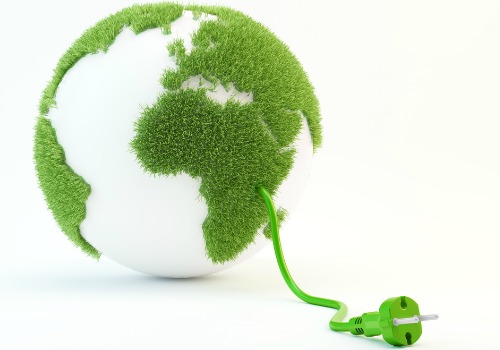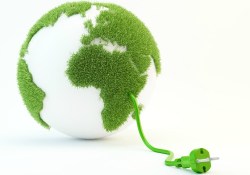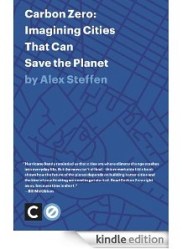 Editor’s note: Welcome to Grist’s presentation of Alex Steffen’s new book Carbon Zero. We’ll be posting a new chapter every day this week — here’s the full table of contents. Read this post for a little more about the project. And if you like what you read, you can order Carbon Zero from Amazon.
Editor’s note: Welcome to Grist’s presentation of Alex Steffen’s new book Carbon Zero. We’ll be posting a new chapter every day this week — here’s the full table of contents. Read this post for a little more about the project. And if you like what you read, you can order Carbon Zero from Amazon.
Before we get on with the business of reimagination, though, we have to pause for some clarification on the matter of energy.
The first response many of us have to the climate crisis is simple: We need cleaner energy. This is not illogical. Most of the emissions warming the Earth come from burning dirty fossil fuels. So, we think, replacing those dirty power sources with clean energy sources should solve the problem. When we first ponder the challenge of making carbon zero cities, most of us fly immediately to the idea of cities covered in solar panels and powered by fields of wind turbines.
But seeing climate change mainly as an energy-generation problem — rather than an energy-use problem — will mean failure. To meet the climate crisis and win, we need to not only change the kind of energy we use, but also (and even more importantly, to my mind) completely rethink our relationship with energy.
The clean energy supply challenge
My support for clean energy is unequivocal. Obviously, we need to be moving quickly towards a world where all the energy we use comes from clean sources. Wind, solar, geothermal, and hydro all have very, very low emissions. (Nuclear is less climate-friendly, once the costs of mining uranium and storing the waste for the necessary 25-100,000 years are factored in, but some smart people like to include nuclear in the clean energy mix.) A world that ran only on these energy sources would be profoundly more sustainable.
Here’s the problem: If we continue using energy as we have, we won’t become a world run on clean energy. Business as usual, according to the U.S. Energy Information Administration (EIA), would see global energy demand jump 44 percent by 2030. The International Energy Agency (IEA) warns that with current policies we may see more than a doubling of world energy use by 2050.
In other words, to “zero out” our emissions solely by using clean energy, we’d have to replace all the dirty energy used on the planet today — the coal, oil, and gas which provide transportation, heating and cooling, electricity, food, and manufactured goods to 7 billion people — with solar, wind, and other clean energy. Essentially we’d need to replace all of the energy used everywhere on the planet. And then — because energy demand is expected to double by 2050 unless we change direction — we’d need do it again, within the next 40 years.
That may be impossible, given even the boldest plans for clean energy production. Energy entrepreneur Saul Griffith gives an excellent talk (available here) in which he illustrates how enormous a job it would be to meet our current energy demand — much less doubled demand — with clean energy sources. We’re talking, after all, about amounts of clean energy generation that are hard to even fathom, much less plan for: forests of wind turbines off all our coastlines and blanketing the high plains, huge fields of solar panels, nearly every river on Earth dammed, and so on.
It’s true that clean energy innovation is proceeding at a rapid pace. I believe that as clean energy generation drops in price, simple economics will drive a shift to solar and wind. I believe carbon pricing, the elimination of fossil fuel subsidies, and changes in public opinion can massively accelerate that shift. But I don’t believe this will happen on a large enough scale, quickly enough, to make clean energy production the sole (or even primary) focus of climate action while world energy consumption doubles. That’s absurd.
The brutal realities of energy politics
For one thing, some of the largest companies and wealthiest people on the planet are determined to slow the spread of clean energy. These powerful interests are actively hostile to clean energy deployment, have war chests of tens of billions of dollars, and operate what’s probably the nastiest, smartest, best-funded political lobby in history.
If we bet on clean energy as our climate strategy, in order to win we must produce massive amounts of clean energy very quickly; yet our ability to get new clean energy sources up and running brings us into direct conflict with forces (oil prices, national regulators, financial markets, international agreements) that are often largely out of our control. The energy sector is especially subject to political delay, and in the U.S. and Canada, clean energy shows no sign of breaking free of the political logjam.
It’s true that external events might break up that logjam for us. The wildcard here is oil prices and their effects. Since we are likely past peak production of oil (and the oil supplies that remain are increasingly lower in quality, harder to get to, or both), prices are essentially certain to rise over time. The only question is by how much. The EIA forecasts oil prices rising to $110 a barrel in 2015 and $130 in 2030. Many other forecasters see much higher oil prices, up to $200 a barrel or more by the end of this decade.
Quickly rising oil prices will make transitioning to more efficient energy uses and clean energy sources easier. Slow-rising oil prices will make it harder. For oil companies, the ideal is that prices rise enough to make them maximum profits without rising high enough to spur a rapid transition. As Saudi Prince Alwaleed bin Talal admitted recently to CNN, “We don’t want the West to go and find alternatives, because, clearly, the higher the price of oil goes, the more they have incentives to go and find alternatives.” (Alwaleed also owns the fourth-largest stake in Rupert Murdoch’s News Corp, which may help explain some of that company’s climate denialist stances.) Another lead Saudi official told Reuters that climate treaty negotiations are “one of the biggest threats that we are facing.”
The worst-case scenario is that prices remain low for a decade or two, then skyrocket. That would mean rising emissions, followed by a severe strain on the global economy, making transition more expensive and difficult, and it would likely lead to an economy that has high emissions and low growth. The best-case scenario would see steadily rising costs starting now, so that we have the ability and incentive to transition quickly. Which scenario plays out is, unfortunately, essentially out of the control of advocates, and even most national governments. Politics severely constrains our ability to choose our energy sources.
The other energy path
We can choose how we use energy, though.
I’m not talking about efficiency — if by efficiency, we mean doing the same things, better. We tend to think of our economy and its energy demand as more or less a given, and efficiency gains as something that happens slowly and incrementally to improve that economy. For instance, many economists make predictions with apparent confidence that in order to generate X amount of economic growth we will need Y amount of energy. The theory is we’re already doing the right things; all we can hope for is to do them a little differently, a little more efficiently. (Others, like Amory Lovins, say we can do them much more efficiently, but most efficiency experts still see the overall patterns of our lives changing little.)
The way we live now, though, is not the pinnacle of prosperity: Progress didn’t end with 20th-century city-building approaches. Sprawl, malls, and highways aren’t the last word in wealth.
The greatest lever for changing the nature of prosperity is our cities. Cities abound with opportunities for transformation. In fact, the workings of almost every system in almost every city can be redesigned to use less energy while leaving us more prosperous.
And using less energy means a lot less demand for energy generation. Designing out energy and materials use within a city creates cascading reductions all the way down the supply chains that serve that city. Because these supply chains are full of waste (no industrial process is perfectly efficient and many industrial systems today pay at best passing attention to energy efficiency), reducing the need for the final product in a system often produces incredible savings as that reduced demand echoes out.
Let’s look at an example. When we turn on an air conditioner, the energy used to cool the room is a small fraction of all the energy used to power the machine. How? First of all, engineers tell me even the most efficient air conditioners only put out about one-quarter as much cooling energy as the energy they take in; the rest is wasted in the process of cooling the air. But in order to produce even that blast of cold air, electricity flowed into the home through the power grid. Along the way, energy was wasted in transmission line losses. The power plant on the other end of that power grid usually wastes vast amounts of energy generating electricity (coal-fired plants can waste half of the energy they generate by burning the coal that feeds them). The result can easily be that 10 times as much power is generated as is actually used to cool the room. This doesn’t even begin to account for the energy costs of manufacturing air conditioners, stringing power lines, mining coal, or building power plants (or maintaining that whole system).
As long as we rely on that air conditioner alone to make a building livable on a hot summer day, the best we can do is try to make each of these steps (power generation, electricity transmission, air conditioner operation) less wasteful.
However, as we’ll see in the second chapter, the building itself can also change. Buildings can be designed (and retrofitted) to require much less air-conditioning (or even none). Cities can be landscaped and designed to keep urban temperatures lower. And, of course, cultural norms can change from expecting a chilly but stuffy room in the middle of summer to being happy with a not-too-warm room that has natural ventilation. A city with buildings designed for natural cooling, shaded by street trees, and lived in by people who don’t expect to wear wool suits in midsummer — such a city might well do away with many of its air conditioners. In so doing, the citizens of that city would not only cut the energy use of their air conditioners, they’d essentially eliminate the need to generate perhaps 10 times that amount of energy in the first place. Make enough buildings cooler, get rid of enough air conditioners, and cascading energy savings mean pretty soon you’re closing down coal plants.
The power of cities
Cities offer the leverage for these sorts of changes. National and international standards and policies matter, of course, but the vast majority of decisions on things like building standards, urban design, and infrastructure are made at the local level. Cities are where demand reduction happens.
And many of the opportunities to cut energy use are mutually reinforcing, meaning that the more of them our cities pursue at the same time, the more affordable big shifts in energy use become. (Combine the synergies of these urban solutions with the fact that energy prices are predicted to become a major drag on urban economies, and big energy-use reductions not only become feasible, they show themselves to be engines of economic growth.)
Instead of achieving emissions cuts by trying to build wind turbines that outcompete coal plants (on a political playing field tilted against them), these cities eliminate our need for coal plants to begin with. We’ll still need a lot of wind turbines. But supplying clean energy to cities that use a small fraction of the energy they do today is a much cheaper and more achievable goal than trying swap the entire power system with clean alternatives.
The ability to drop energy demand and meet that lower demand with realistically deployable clean energy makes carbon-zero cities possible. If a city can reduce its energy use by 90 percent, covering the remaining 10 percent with clean energy is an entirely achievable task (and one amenable to a “local energy” approach). Balancing the remaining (non-fossil-fuel) emissions with ecological restoration efforts that soak up CO2 would then result in a carbon zero city — a city that in effect produced no net greenhouse-gas emissions at all. Indeed, carbon zero cities could over time become climate-repairing cities, their actions drawing more greenhouse gases out of the atmosphere than they emit.
If we build them right, carbon zero cities will outshine the cities we live in today. The idea that high energy use equates high quality of life is an outdated 20th-century one. People will live better in carbon zero cities, in part because of their lower energy use. Communities will be more vibrant and healthier; streets will more walkable and safer; local businesses will thrive; entrepreneurial opportunities will increase; and neighborhoods will be better prepared to survive hard times, whether those hard times come in the form of storm surges or skyrocketing oil prices. We’ll be thankful we acted while there still was time. Our kids and grandkids will be even more grateful.
So, climate change is likely unsolvable as an energy problem, but it looks entirely solvable as a cities problem. What follows is my best educated guess at what a workable set of such urban climate solutions might be.
Read on: Urbanism: Why good walksheds mean lower emissions





